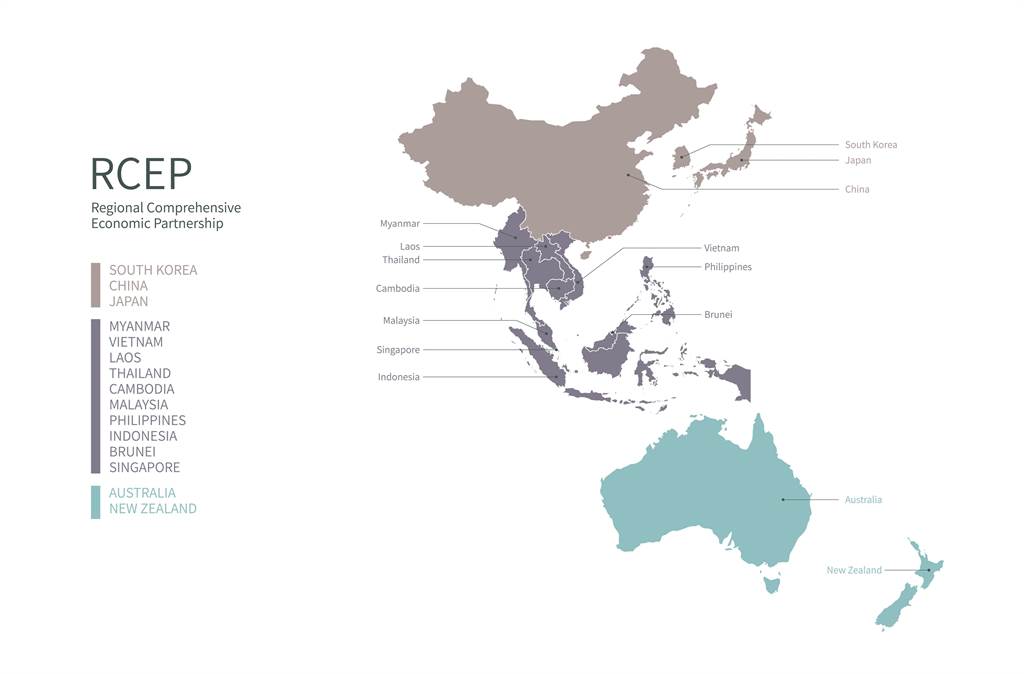Is RCEP going to affect Taiwan or your business?
What is going to happen with Japan, Korea, China?

RCEP (Regional Comprehensive Economic Partnership) has been signed in Nov, 2020.
Unsurprisingly, Taiwan was not included given the tense relationship of China with the increasingly assertive Taiwan and the USA.
After 8 years at the negotiating table, the agreement was signed by Asia-Pacific nations of Australia, Brunei, Cambodia, China, Indonesia, Japan, Laos, Malaysia, Myanmar, New Zealand, the Philippines, Singapore, South Korea, Thailand, and Vietnam. India was also included initially, however, they pulled out owning to the concerns that the free trade agreement may harm their local business due to the overlapping products, and price competition between China and India.
Why is RCEP important to us?
The 15 member countries account for about 30% of the world’s population (2.2 billion people) and 30% of global GDP ($26.2 trillion) as of 2020, making it the biggest trade bloc in history.
Who is going to benefit?
Let’s have a look at the upsides and why do the 15 member countries need RCEP on top of the existing free trade agreements?
1. Tariff-free
Although this will not become effective immediately; tariffs are expected to be lowered gradually over a 10 year period.
2. New rule of origin
With the FTA, the origin of products was always confusing and complicated because most of the products are not manufactured in one country. This made it difficult to decide which country the products were manufactured in and how much tax they should be charged accordingly. Now, with RCEP, all the products within member countries will be treated equally. This might give companies in RCEP countries an incentive to look within the trade region for suppliers.
3. GDP contribution within Asia-Pacific nations in the long term
We expect to see the GDP growth within the member countries once this regional economic has been formalized and begins to run smoothly.
How is this going to affect Taiwan?
Well, Taiwan is not part of this epic bloc, is it a big deal? Now, let’s look back to see what was working in the past and understand what we are missing out on.
What trade agreements does Taiwan already have in place and that will remain unchanged?
- 70% of our export products are already free of tariffs. This is especially true for integrated circuits, semiconductors and ICT products that have been traded and protected with ITA, ITA 2.
- 30% of exported products were and are still subject to tariffs, especially in machinery, petrochemical and textile industries.
- Equal trade agreements between Taiwan and Japan, Taiwan and South Korea, Taiwan and China.
Now we know that RCEP may affect Taiwan’s positions under headings 2 and 3.
Let’s talk about how RCEP may affect the 30% of Taiwanese companies given that China, Japan and South Korea now share the new favorable trade conditions.
In 2019, Taiwan exported US$91.8 billion worth of goods to mainland China, US$23.1 billion to Japan, and US$16.9 billion to South Korea.
We can see that RCEP will likely affect the machinery, and petrochemical industries in Taiwan.
However, for textile industry, maybe not so much anymore! Now let’s review what these industrial sectors have contributed to the Taiwanese economy before the RCEP.
For machinery industry, Taiwan’s biggest export country is China. The number of machine tools exported from Taiwan to China (including Hong Kong) was US$903 million in 2019. For petrochemical industry, Taiwan is ranked as the 4th largest gasoline exporter in Asia, after China, India, and South Korea.
Should we worry about this? Perhaps not yet.
Here are the reasons:
- Most of the manufacturers in the machinery and textile industries have moved out of Taiwan and relocated in low labor cost countries such as Cambodia, Vietnam some time ago. Right now these manufacturers mainly keep their HQs in Taiwan and even with the recent Taiwanese manufacturer withdrawal from China, they largely did not relocate their factories back to Taiwan but to Vietnam.
- Decreasing importance of the petrochemical industry. This industry is highly polluting. Even prior to the RCEP, the Taiwanese petrochemical industry has already faced strong market competition from global players, manufacturing capacity constraints, and tightening environmental restrictions. A new business model and product segments should be developed to address the decreasing market share problems. With, or without RCEP, the whole industry has started to take actions to upgrade the products and services, or to relocate.
- RCEP will not enact immediate reductions in tariffs for machinery, petrochemical and textile industries with Japan, China and South Korea. The tariffs on textile products will be gradually lowered over a 10 year period. Therefore the impact on these three industries in Taiwan will not become apparent in the short term. However, hopefully RCEP will provide an incentive for the Taiwanese industry to accelerate industrial transformation and innovation in order to remain competitive.
Then, what should we actually worry about?
With the change in the US government, there is a question whether the USA will maintain the aggressive stance towards the Chinese trade and geopolitical influence. Will the USA aim to rejoin the CPTPP agreement that is championed by Japan and excludes China? How can Taiwan protect our industries and reduce the Chinese impact on the global supply chain?
Will India, who bailed out of the RCEP at the last minute instead work closer with Taiwan in order to limit the impact of RCEP among the Asia-Pacific nations? Will their concerns about China misusing RCEP to bypass pricing controls and dump low cost Chinese made products in member countries’ markets come true?
Does RCEP bring only benefits to its signatories? Who will be the biggest winner, China, Japan or Korea?
Let’s wait and see!
Reference:
Taiwan-petrochemical-industry-outlook
Taiwan chemical industry’s uncertainties
shutterstock達志影像
Ask Taiwan, your dependable sourcing and business partner in Taiwan
